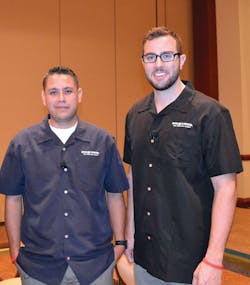How can dealers get more cars on the alignment rack? Matthew Greco and Jose Perez answered that question in a seminar at Big O Tires LLC’s annual dealer meeting last April.
Greco is an owner of Golden West Tire Centers LLC, which operates 24 Big O Tires stores in California and Colorado. Jose Perez is the company’s director of operations. (The seminar also included a presentation by Kent Coleman, who owns five Big O Tires stores in the Salt Lake City, Utah, area, on equipment-related issues.)
Greco and Perez shared ideas franchise owners could use to reach Big O Tires’ alignment service sales goals. The company wants every Big O Tires store to reach an alignment-to-car ratio of 25% in 2016.
At 32% alignment to cars in 2015, Greco’s Chino, Calif., store was performing well above the company’s benchmark. But could it sell even more alignments? Greco offered his Chino store, which he had purchased in the summer of 2015, to Big O Tires’ Best Practices committee to find out.
“Our goal is to really focus on developing a profitable tire department,” said Greco.
“With tire margins compressing every year, offering our Tire Protection Package and alignments are two ways to develop a profitable tire department.” The Tire Protection Package, or TPP for short, is Big O Tires’ warranty program.
The Chino store is managed by Sarf Bawa. “We didn’t want to take someone who was crawling and have him sprint. We wanted to take someone who was already running at a pretty good pace and see how fast they could go,” said Greco.
“We picked Sarf and his team. In 2015 they were running at 32%. In a three-month test of best practices, he ratcheted that up to 41%. That increase is impressive, but what I think is even more impressive is the average alignment price. We were already running at $170 average, and he was able to maintain that. In fact, he increased it by 60 cents.”Ask for the alignment
How did the Chino team do it? For starters, they adopted a recommendation from Big O Tires’ Best Practices Committee: Ask for the alignment. “Employees began tracking how often they were asking people for alignments, and it was a contest within the store,” said Greco.
The Chino store also set a goal to have alignment sales come in between 10% and 15% of total sales dollars. They hit 14% in February 2016, for an overall 62.6% gross profit margin. In the next month, the Chino team pushed gross profit to 64%.
“Prior to us taking over the store, which was in the middle of the year, they were running at 53% or 54% GP,” said Greco. “We took over the store in July and for the rest of the year ran at about 58% to 59% GP. Since beginning the best practices plan with the alignments, we’re pushing 64% GP.”
Alignment sales have a ripple effect
The focus on alignment sales touched other aspects of the store’s operations. “Having a profitable tire department helps all things,” said Greco.
“We use tires to sell other services, so we saw GP go across the board in a positive way. We’ve also seen competition among stores. Because we have a cluster of stores that are close to each other, the managers are really competitive.”
Low-volume versus high-volume stores
The Chino store is a low-volume store. Would the Best Practices Committee’s suggestions work in a store with a large customer base? A high-volume store in Colorado proved they do.
Greco purchased nine stores in the Western Slope region of Colorado in September 2015. “When we took over those stores they were doing less than 10% of their alignments to sales. In fact, a store that was doing $250,000 to $270,000 a month was really only doing $7,000 to $9,000 in alignments.”
He applied the Best Practices Committee’s recommendations at one of the stores. Within 90 days, the store had $30,000 in alignment sales in one month. “The best practices can work for a high-volume store and a low-volume store. It’s whether or not you have buy-in and the right checks and balances to measure it,” said Greco.
Set daily goals
The Golden West stores set daily goals, according to Perez. “We shoot for 12 alignments a day, but we understand to get to 12 alignments we have to check about 85% of the vehicles that come through our service bays based on our current car counts.”
The Chino store, for example, checked alignments on 85% of vehicles and the return was about 41% in February 2016. “It’s really just getting the guest in for that complimentary check and then moving forward from there based on their vehicle requirements, factory recommendations and customer preference,” Perez told dealers.
He said selling alignments starts when an employee greets a customer. Employees are trained to provide customer service in a process called VIP Service at every customer interaction.
“We focus on a proper VIP,” said Perez. “Turning the wheel, getting the guest to visually see what we’re seeing. Run your hand to that tread, find the uneven wear, and offering services based on their needs throughout the VIP process.”
Reinforce alignments across the board
Greco feels that from time to time Big O Tires stores follow VIP Service protocols when customers come in for tires, but often do not for non-tire purchases.
“We have to be diligent about that because there are a lot of things that come up. You have to reinforce the alignment business through all facets of your business,” he said.
To help raise customer awareness, all of Greco’s marketing pieces include a sunburst graphic touting the complimentary alignment checks.
“It gets the narrative going in the guest’s mind because we reinforce that across the board. So in all of our online business, in all of our direct mail, we promote free alignment checks. It doesn’t cost anything. The sunburst is right on the ad. Now they’re thinking about it,” said Greco.
Discover the need
If the alignment is not sold in the store’s parking lot, there are other opportunities to discover a customer’s need for an alignment.
The Big O Tires’ Best Practices Committee recommends stores adopt a “chalk-and-talk” program. When the car is on the lift, the technician can examine the tires and mark any imperfections with chalk.
At checkout, the customer sees the tires and asks about the chalk marks, beginning a conversation that can lead to an alignment sale.
Greco told dealers it is critical to have someone dedicated to the alignment rack all day long. The Chino store has a dedicated alignment technician.
At his other stores, auto service technicians perform alignments. Tire technicians are trained to get the car on the rack and check the alignment.
Offer multiyear packages
Many Big O Tires stores offer customers the option to purchase an upgrade to the standard 90 days or 4,000 miles alignment warranty at checkout.
A point-of-purchase (POP) display at the checkout counter explains the prices and benefits of the one-, three-, and five-year alignment packages. A vehicle’s alignment is checked as many times as needed over the months the warranty covers.
“We’ve seen a huge increase in sales because of that visual aid,” said Greco. “It’s always nice to have something to refer to when you’re talking to customers.”
Four quick tips on how to sell more alignments
Here are some tips on increasing your vehicle percentage and gross profits from alignments, courtesy of Big O Tires:
- Display a counter card that explains alignment packages.
- Add a complimentary alignment check to every new tire package, rotation/balance package, and oil change package.
- Add value to the alignment. Help customers understand that tires working in harmony improve fuel economy and increase tire life. Customers need to know that tire warranties include exclusions against misalignment. If tires wear out due to misalignment, the warranty is voided.
- After printing a repair order, inform customers of all services to be performed during the visit, including the complimentary alignment check. Do not ask to check alignment; tell customers it will be done.
About the Author

Ann Neal
Ann Neal is a former senior editor at Modern Tire Dealer.
